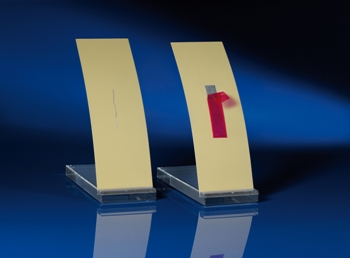A new self-adhesive tape simplifies the process of pickling aluminum surfaces. It is safer than existing treatment methods involving pickling pastes, sprays or baths, because there is no rinsing stage and hence no need for complicated wastewater disposal.
 Application of pickling tape prior to the repair of damaged paint. The paint has been removed by mechanical abrasion and the pickling tape is used for pre-treatment of the metal surface. After removal of the tape and simple cleaning with a damp cloth, the surface is ready to receive a fresh coat of paint. © Fraunhofer IFAM
Application of pickling tape prior to the repair of damaged paint. The paint has been removed by mechanical abrasion and the pickling tape is used for pre-treatment of the metal surface. After removal of the tape and simple cleaning with a damp cloth, the surface is ready to receive a fresh coat of paint. © Fraunhofer IFAM
Aluminum is a light metal used wherever low weight is a prime consideration. Traditionally used in aircraft construction, it is increasingly employed in other sectors such as automotive engineering. But as a base metal, aluminum requires protection against corrosion, which is usually achieved by a special paint or other surface coating. Adhesive bonding is becoming increasingly popular as a means of joining lightweight metal components. But aluminum cannot be coated or bonded without an appropriate pre-treatment to remove undefined deposits of oxides, hydroxides or other contaminations that are almost always found on technical aluminum surfaces. Pickling is one of the most common techniques employed for this purpose. It involves immersion of the components in a solution of chemicals that dissolves the contaminants and provides a perfectly clean metal surface.
The use of a pickling bath is difficult when dealing with large components that only require treatment of part of their surface, or when components are being reworked or repaired. Local pre-treatment methods are increasingly preferred in such cases. Manufacturers mainly use pickling agents in paste or spray form, which are spread or sprayed onto the metal surface manually by trained technicians. The problem is that the chemicals employed are strongly acidic or alkaline. Consequently, the surrounding areas of metal have to be carefully masked off. A subsequent rinsing stage is required to remove the pickling agent, and the corrosive wastewater has to undergo special treatment prior to disposal. “None of the currently available local pre-treatment solutions is entirely satisfactory. That’s what led us to the idea of developing a pickling tape that can be easily applied to the areas that require pre-treatment,” says Dr. Malte Burchardt of the Adhesion and Interface Research department at the Fraunhofer Institute for Manufacturing Technology and Advanced Materials IFAM in Bremen, describing IFAM’s approach.
Novel adhesive with high water content
To realize this objective, it was necessary to develop an entirely new adhesive for the pickling tape that would enable it to be applied as easily as any other self-adhesive tape and removed without leaving any residues. Moreover, all of the chemicals required for the pickling process had to be integrated in the adhesive. “An adhesive for pickling applications needs to have a high water content, whereas 95 percent of all conventional adhesives used in self-adhesive tapes are solvent-based. This means they stop working when they come into contact with water,” explains Dr. Malte Kleemeier of the IFAM Adhesives and Polymer Chemistry department. The Fraunhofer scientists met this challenge by developing a suitable adhesive formulation based on water-soluble polymers.
Practical tests have demonstrated that the new technology is just as effective as conventional bath pickling and alternative paste or spray methods. And unlike existing techniques, it doesn’t produce corrosive wastewater requiring special disposal measures. The treated component merely has to be wiped clean with a damp cloth after the pickling tape is removed. “Our pickling tape is easy to handle, safe, and environmentally friendly,” says Kleemeier, summarizing its advantages.
The researchers developed the new self-adhesive tape in collaboration with industrial partners from various sectors including aeronautical and automotive engineering. With their high quality standards, these sectors are the ideal proving ground for the pickling tape. In 2012, its developers received the “SURFAIR Award for Innovation”.
In the next step, IFAM and its partners intend to ready the tape technology for production. They will also conduct tests to evaluate the suitability of the pickling tape for use with other materials such as stainless steel.